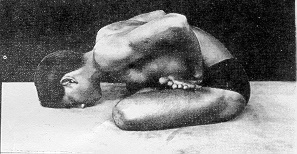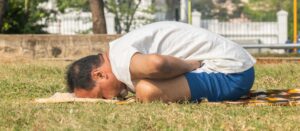What is yoga-mudra (yoga seal pose)?
In yoga-mudra, the practitioner sits in padmāsana, then placing the hands on the heelsbends forward to touch the face to the ground. This is an advanced āsana and should be learned under expert guidance.
How does one practice yoga-mudra technique? (should be learned under supervision)

- Sthithi (starting) position: First, sit in Padmāsana. Experience the balance.
- Second, place hands on the heels with wrists towards abdomen. Breathe in.
- Then, breathing out, bend forward till face touches the ground. However, if you are doing this for the first time, bend forward only till you reach the limits of comfort.
- Now, hold for 10 counts.
- Breathing in, bring body back to starting position in padmasana (sthithi).
- Lastly, release the legs from padmasana and sit normally.
- Importantly, once is enough. Increase duration slowly.
- The dṛṣṭi (gaze) recommended is nāsikāgra-drishti (tip of the nose gaze) or the svādhiṣṭhāna-cakra.
What are the benefits of practicing yoga-mudra?
- Importantly, the action of bending forward against resistance of the heel stretches the lower back. As a result, there is toning up of the back which increases strength as well as flexibility. Additionally, this stretching also energises cartilages along the spine and tones it up.
- Also, the bending action pushes heel of the hand into the cecum and sigmoid colon. Consequently, this forward bending action compresses the lower abdominal viscera and induces peristalsis. So, this exercise is good for curing constipation.
- Additionally, the action of pushing also invigorates all the organs in the abdomen such as pancreas, liver, and intestines and stimulates their functioning and interaction.
- Finally, this āsana removes excess adipose tissues and reduces fat to a small extent.
- Lastly, yoga-mudra is good for stabilising menstrual issues.
What are the possible yoga-mudra contraindications?
 First, if you have any form of back ache, do not attempt this āsana without adequate supervision and support.
First, if you have any form of back ache, do not attempt this āsana without adequate supervision and support.- Importantly, people with lower back problems and circulatory disorders should not attempt this āsana without first consulting a physician.
- Additionally, people with liver illness and hernia etc should avoid this āsana.
- Lastly, this āsana should not be practiced during menstruation or pregnancy.
Some noteworthy points on yoga-mudra
Internal Links: Dharma (conditioning), Stress and Situational Awareness, Prana, Asana sequence, Asana schedule, Asana Focus or gazing, Pranayama, Hatha Yoga Pradeepika
External Links: Prana, Chakra, Pancha Tattva, Pancha Prana, Pancha Kosha, Nadi,
- Those with lower back problems should not go to the complete position. Instead, it is advisable that they go forward till there is discomfort in the lower back and stop. Do sethubandasana after this mudra.